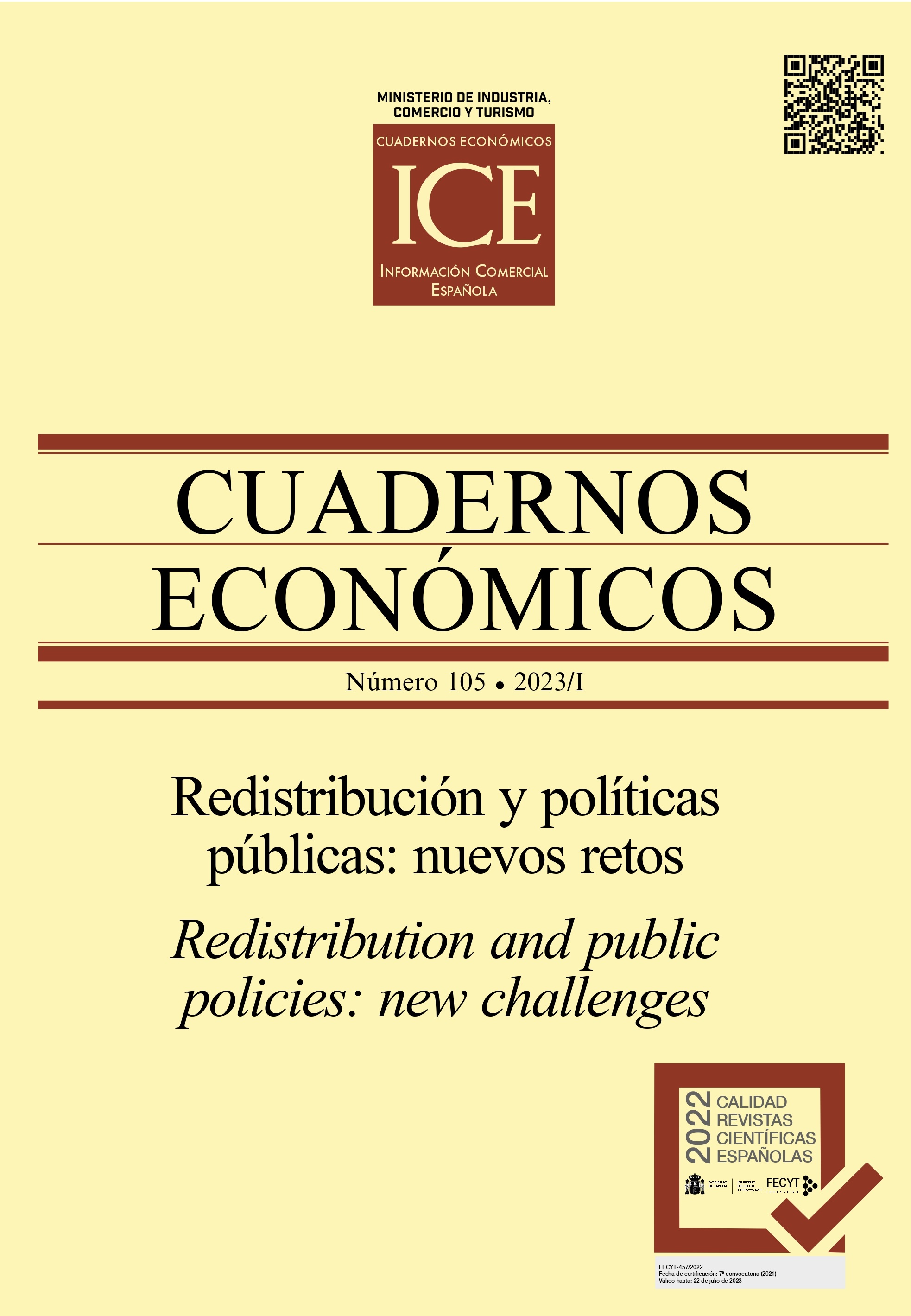Optimal personal income taxation: What do we know about the relationship between redistribution and efficiency costs?
##plugins.themes.bootstrap3.article.sidebar##
Downloads
##plugins.themes.bootstrap3.article.main##
Optimal taxation theory offers recommendations on the design of a non-linear income tax that, while minimizing efficiency costs, maximizes redistribution. To make such recommendations operational, it is necessary to know the taxpayers' response elasticity to increases in the marginal tax rate, which together with the shape of the labor income distribution and social preferences for redistribution end up determining the optimal design of the tax. Economic theory and the estimators provided in the literature, therefore, provide the social decision maker with powerful instruments to guide the tax design. This is what is reviewed in this panoramic article.
##plugins.themes.bootstrap3.article.details##
Almunia, M., & López-Rodríguez, D. (2019). The elasticity of taxable income in Spain: 1999–2014. SERIEs, 10(3), 281-320.
Atkinson, A. B. (2015). Inequality. What Can be Done?. Harvard University Press.
Atkinson, A.B., & Stiglitz, J.E. (1976). The design of tax structure: direct versus indirect taxation. Journal of Public Economics, 6(1-2), 55–75.
Banks, J., & Diamond, P. (2010). The Base for Direct Taxation. En J. Mirrles, S. Adam, T. Besley, R. Blundell, S. Bond, R. Chote, M. Gammie, P. Johnson, G. Myles y J. Poterba, The Mirrlees Review: Dimensions of tax design, Capítulo 6, (pp. 548-648). Oxford University Press.
Blundell, R., Bozio, A., & Laroque, G. (2011). Extensive and Intensive Margins of Labour Supply: Working Hours in the US, UK and France. American Economic Review, 101(3), 482-486.
Boadway, R., Marchand, M., & Pestieau, P. (1994). Towards a theory of the direct-indirect tax mix. Journal of Public Economics, 55(1), 71-88.
Boadway, R., & Cuff, K. (2022). Tax Policy. Principles and Lessons. Cambridge Elements. Elements in Public Economics. Cambridge University Press.
Chetty, R. (2009). Is the Taxable Income Elasticity Sufficient to Calculate Deadweight Loss? The Implications of Evasion and Avoidance. American Economic Journal: Economic Policy, 1(2), 31-52.
Deaton, A. (1979). Optimally Uniform Commodity Taxes. Economics Letters, 2(4), 357–61.
Diamond, P. A. (1998). Optimal Income Taxation: An Example with a U-Shaped Pattern of Optimal Marginal Tax Rates. American Economic Review, 88(1), 83–95.
Diamond, P., & Saez, E. (2011). The Case for a Progressive Tax: From Basic Research to Policy Recommendations. Journal of Economics Perspectives, 25(4), 165-190.
Esteller-Moré, A. (2021). Imposición óptima y descentralización fiscal: El caso del IRPF. Investigaciones Regionales / Journal of Regional Research, 49(1), 29-44.
Esteller-Moré, A. (2022). Impuesto sobre el patrimonio: de la teoría a la práctica. Economistas, 178, 108-116.
Feldstein, M. (1999). Tax Avoidance and the Deadweight Loss of the Income Tax. Review of Economics and Statistics, 81(4), 674–80.
Gruber, J., & Saez, E. (2002). The Elasticity of Taxable Income: Evidence and Implications. Journal of Public Economics, 84(1), 1–32.
Haig, R. M. (1921). The Federal Income Tax. Columbia University Press.
Harju, J., & Matikka, T. (2016). The elasticity of taxable income and income-shifting: what is “real” and what is not?. International Tax and Public Finance, 23(4), 640–669.
Jacobs, B. (2013). From Optimal Tax Theory to Applied Tax Policy. CESifo Working Paper No. 4151, Center for Economic Studies and Ifo Institute (CESifo), Munich.
Kaldor, N. (1955). An Expenditure Tax. Allen and Unwin, Londres.
Kleven, H. (2021). The EITC and the Extensive Margin: A Reappraisal. (NBER Working Paper No. 26405). National Bureau of Economic Research.
Kleven, H., Landais, C., Munoz, M., & Stantcheva, S. (2020). Taxation and Migration: Evidence and Policy Implications. Journal of Economic Perspectives, 34(2), 119-142.
Meade, J. (1978). The Structure and Reform of Direct Taxation: Report of a Committee
chaired by Professor J. E. Meade for the Institute for Fiscal Studies. George Allen & Unwin, Londres.
Mirrlees, J. A. (1971). An Exploration in the Theory of Optimal Income Taxation. Review of Economic Studies, 38(2), 175–208.
Neisser, C. (2021). The Elasticity of Taxable Income: A Meta-Regression Analysis. The Economic Journal, 131(640), 3365-3391.
Oates, W. E. (1999). An Essay on Economic Federalism. Journal of Economic Literature, 37(3), 1120-1149.
Piketty, T., & Saez, E. (2013). Optimal Labor Income Taxation. En A. J. Auerbach, R. Chetty, M. Feldstein y E. Saez, Handbook of Public Economics, Vol. 5, (pp. 391–474). Elsevier.
Piketty, T., Saez, E., & Stantcheva, S. (2014). Optimal Taxation of Top Labor Incomes: A Tale of Three Elasticities. American Economic Journal: Economic Policy, 6(1), 230-271.
Pressman, M. (2018). The Ability to Pay in Tax Law: Clarifying the Concept's Egalitarian and Utilitarian Justifications and the Interactions between the Two. N.Y.U. Journal of Legislation and Public Policy, 21, 141-201.
Rubio Guerrero, J. (1986). El impuesto sobre el gasto personal: información necesaria para su gestión. Papeles de Economía Española, 27, 303-305.
Saez, E. (2001). Using Elasticities to Derive Optimal Income Tax Rates. Review of Economic Studies, 68(1), 205–09.
Saez, E. (2002). The Desirability of Commodity Taxation Under Non-Linear Income Taxation and Heterogeneous Tastes. Journal of Public Economics, 83(2), 217-230.
Saez, E., & Stantcheva, S. (2018). A simpler theory of optimal capital taxation. Journal of Public Economics, 162, 120-142.
Salanié, B. (2003). The Economics of Taxation. MIT Press.
Sandmo, A. (2015). The Principal Problem in Political Economy: Income Distribution in the History of Economic Thought. En A. B. Atkinson y F. Bourguignon, Handbook of Income Distribution, 2A, (pp. 3-65), Elsevier.
Schanz, G. (1896). Der Einkommensbegriff und die Einkommensteuergesetze. FinanzArchiv,13, 1–87.
Simons, H. C. (1938). Personal Income Taxation. University of Chicago Press.
Slemrod, J., Yitzhaki, S., Mayshar, J., & Lundholm, M. (1994). The optimal two-bracket linear income tax. Journal of Public Economics, 53(2), 269-290.
Slemrod, J., & Gillitzer, C. (2014). Tax Systems. MIT Press.
Slemrod, J., & Kopczuk, W. (2002). The optimal elasticity of taxable income. Journal of Public Economics, 84(1), 91-112.
Sørensen, P. B. (2005). Dual Income Taxation: Why and How?. CESifo Working Paper No. 1551, Center for Economic Studies and Ifo Institute (CESifo), Munich.
Tuomala, M. (1990). Optimal Income Tax and Redistribution. Oxford University Press.
Tuomala, M., & Weinzierl, M. (2020). Prioritarianism and Optimal Taxation. En M. Adler y O. Norheim, Prioritarianism in Practice, Cap. 4, Cambridge University Press.
Utz, S. (2002). Ability to Pay. Whittier Law Review, 23, 867-889.


